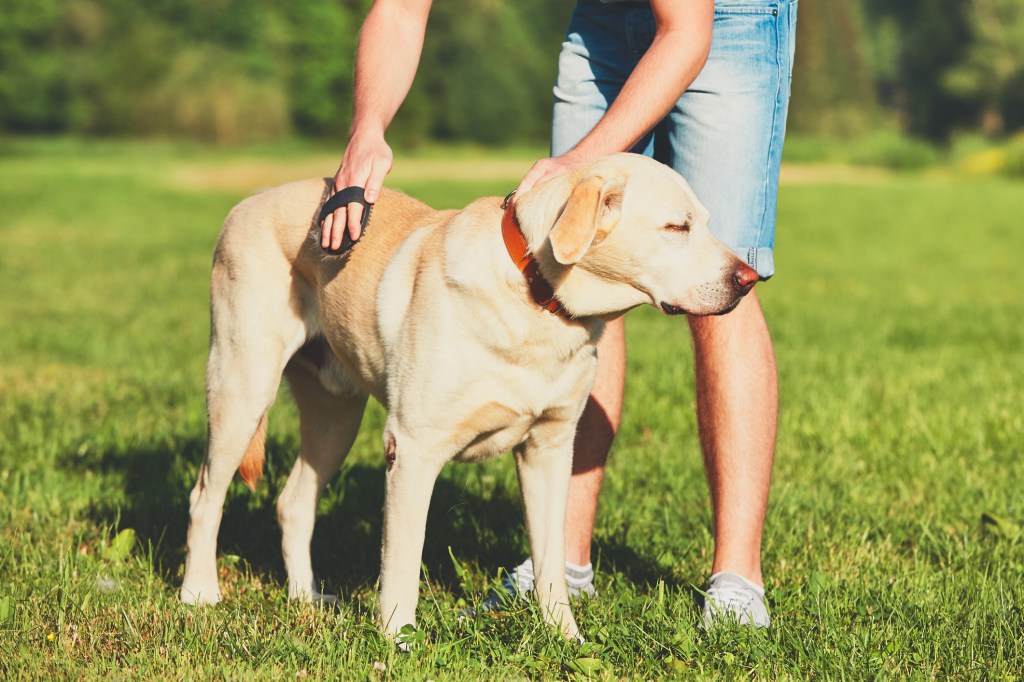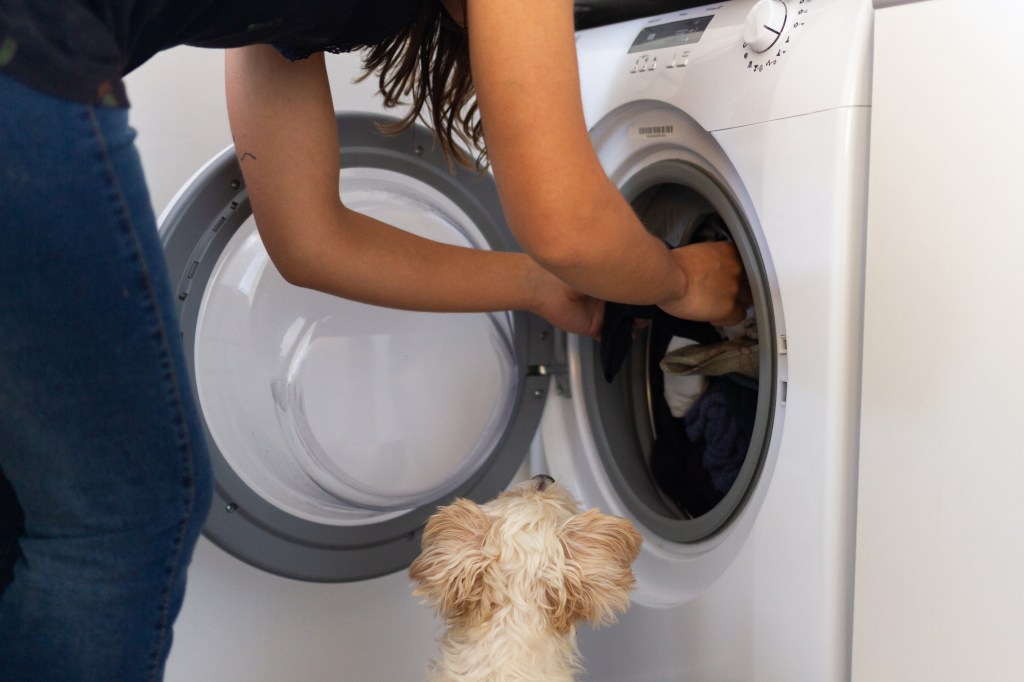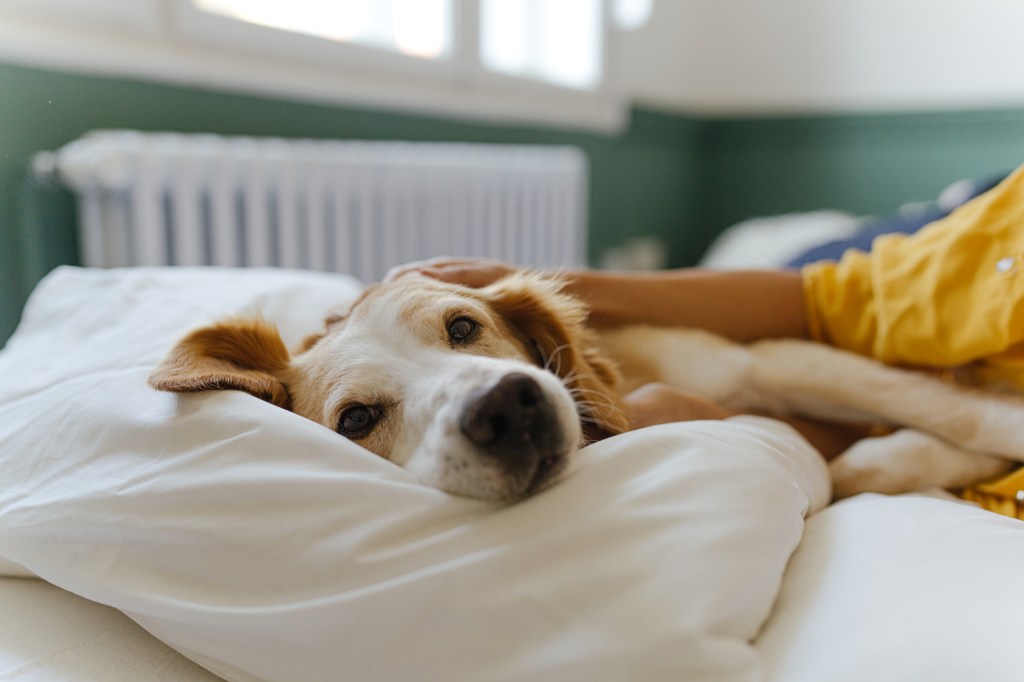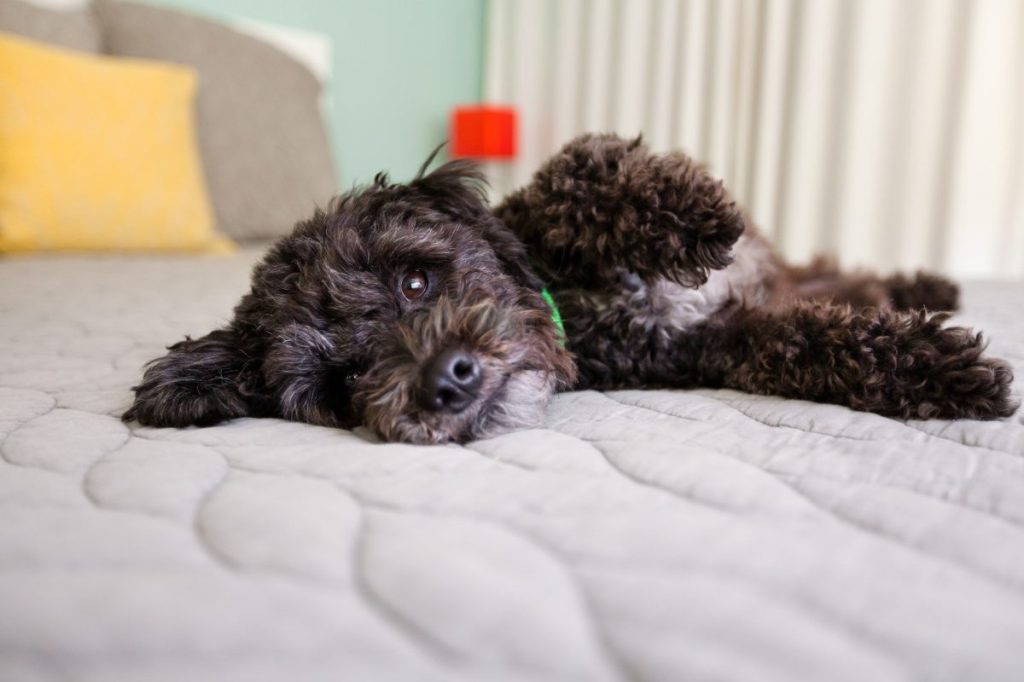If you are a dog owner, you may have already realized your furry friend loves nothing more than cuddling with you in bed. While it can be comforting and cozy, the aftermath of these snuggle sessions is not so pleasant. Dog hair gets everywhere — and sometimes, it can also cause allergies and other respiratory issues for those who are sensitive to it.
Whether your pooch has long or short hair, shedding is a natural process that you just can’t avoid. That’s especially true if you have a breed of dog who sheds a lot. Despite that, it doesn’t mean you have to spend hours every week trying to keep your mattress and sheets hair-free. Luckily, there are several easy and effective ways to remove dog hair from your bed, ensuring that you and your pet can both rest easy at night.
Why it is important to keep your bedding dog fur-free
When it comes to sleep hygiene, most of us tend to focus on factors such as mattress comfort, temperature control, sheet thread count, and the darkness of our bedrooms. However, we often overlook one key aspect of maintaining a healthy sleeping environment: keeping our beds fur-free.
Minimized health risks
Snuggling up with your pup in bed might be your favorite activity. However, all that shedding can cause potential health issues. The accumulated fur can collect and trap dust, pollen, and other particles, leading to poor air quality in your bedroom. Furthermore, the buildup of dust and pollen in your bed can trigger allergic reactions, leading to sneezing, congestion, and other symptoms.
Better sleep quality
Sleeping with a lot of dog fur or dog hair in your bed can be uncomfortable. Why? Well, it can make you itchy and scratchy all over. As a result, you may find it difficult to relax and fall asleep quickly. By keeping your mattress and sheets fur-free, you can enjoy a comfortable and undisturbed night’s sleep.
Longer-lasting bedding
Animal fur and dander can get trapped in the fibers of your bed sheets, causing damage — as well as wear and tear — over time. In some cases, the hair can cause pilling or discoloration of your sheets, blankets, and comforter, thereby shortening their lifespan. With no fur around, your textiles will last much longer, and you won’t need to replace them as frequently.
Improved aesthetics
Pets may light up our lives, but their fur can quickly take away from the aesthetic appeal of your bedroom. A fur-free bedding environment can help to enhance your bedroom’s look and make it more inviting and attractive to you and your guests.
Odor control
In addition to the visible accumulation of hair, dog fur on your bed can produce an unpleasant odor, leading to discomfort and dissatisfaction. Regular cleaning and washing can eliminate this odor and ensure that your bedding remains both fresh and welcoming.
How to remove dog hair from your bed

Removing dog hair from your bed can be quite a daunting task. It can take hours of vacuuming and brushing. Despite that, you may still end up with pesky strands clinging to your sheets. Fortunately, there are a few tips and tricks you can use to make the process a lot easier.
Use a lint roller
Lint rollers are the go-to choice for most pet owners when it comes to removing dog hair from beds. It is an affordable, easily available, and straightforward solution to the ever-increasing animal fur situation.
So, how do they work? It’s simple, really. The roller is covered in a sticky paper that collects any hair it comes in contact with. However, keep in mind that lint rollers aren’t perfect. Longer hairs can pose a bit of a challenge. For owners of Huskies, Golden Retrievers, Great Pyrenees, or other long-haired breeds, it might be worth exploring other options to get the job done. The lint roller might not be able to effectively extract hair tangled in the blanket fibers.
Another downside of lint rollers is that they eventually run out of sticky paper — requiring you to buy replacements. This might not seem like a big deal at first, but if you find yourself de-hairing your bed every day, the costs can pile up. Moreover, there is an environmental toll that comes with relying on single-use products.
Try rubber gloves
Unlike disposable lint rollers, rubber gloves are a reusable and eco-friendly solution that can save you money in the long run. Plus, using them is effortless — slip them on and run your hands across your sheets. The rubber texture creates a static charge that attracts and picks up the pet hair, making it easy to dispose of.
And, if gloves aren’t your thing, there are plenty of other rubber pet hair removal tools on the market to choose from. All of them work similarly, but some popular ones include rubber window squeegees, which can work wonders on stubborn hair buildup.
Run a damp sponge
If you don’t have any fancy tools at home, don’t fret — all you need is a damp sponge! Since hair has a tendency to cling to moist surfaces, a damp sponge can be the perfect cleaning solution. Simply run the sponge over your bed or any other furniture where your furry friend likes to lounge and watch as the hair is whisked away.
The best part is that this method is repeatable, so you can keep going until your bedding is completely hair-free. When the sponge starts to fill up with hair, simply remove the hair and keep on sponging.
Of course, there is always the risk of getting your mattress or sheets wet. However, if you use this method in the morning after you’ve already slept, this shouldn’t be too much of a concern. Make sure to wring out the sponge as much as possible before using it. This way, you can get rid of the hair without any unwelcome wet spots…or the risk of mold and mildew.
Vacuum your bed thoroughly
Most vacuum cleaners nowadays have fancy attachments tailored specifically for furniture. This means that you can use them on your couch, your armchair, and even your bed. In addition, some vacuums even come with brushes designed for tackling pet hair or dog fur. These tools are practicularly great investments if your house is home to a pup who is an excessive shedder.
But before you jump in and start vacuuming away, you need to make sure you have an appropriate device. If your vacuum happens to be quite weighty, things may get a little cumbersome. Depending on your bed’s size, reaching across it with your vacuum hose may be a bit of a mission. In such cases, the trouble may not be worth it. As such, you may need to employ alternative ways to tackle the dog hair.
Try dryer sheets
Dryer sheets are specially designed to attract hair, making them the perfect tool for removing pet hair. All you need to do is grab a few sheets and start running them over your blankets or covers. As you go, the hair will stick to the sheet. Once the sheet is full, toss it away and grab another one. Although you may have to buy more, dryer sheets are relatively affordable. Thankfully, there are also eco-friendly varieties on the market now.
Aside from hair, some pet owners even use dryer sheets to de-fur their pets. It’s important to be cautious, though, as the scents from the sheets can transfer onto your dog’s hair and potentially cause harm if ingested. As a precaution, it’s best to steer clear of direct use on your pooch.
Use a fabric softener spray
Like dryer sheets, fabric softener is also specifically formulated to tackle those stubborn strands of fur. Simply mix it with water in a spray bottle using a 1-to-1 ratio and spritz it on your bed or other areas. This method alone may not always do the trick, but it works wonders when combined with a rubber glove or other rubber tools. However, it significantly simplifies the process of removing the hair, making it far easier than it might be otherwise.
Shake the bed covers outside
This is an old but effective method that’s been used for a long time. Just take your bedding set outside and give it a good shake. This approach is often effective in dislodging a significant amount of dog hair. However, it comes with a few limitations — it’s only feasible if you have easy access to an outdoor space for shaking and it might not completely eliminate all the hair.
It’s best to use this method first to get rid of most of the loose dog fur and then employ other techniques for cleaning the remaining hair.
Use a pet brush

If you are a dog parent, you probably already own a pet brush. Regularly brushing your dog is a crucial part of pet care. Not only does it help in maintaining their coat’s health and cleanliness, but it also reduces shedding and minimizes the spread of fur around your home. Moreover, this tool can be a great way to get rid of the existing dog hair from your bed linens. Just make sure to thoroughly brush the entire surface of the bedsheet.
How dog hair can ruin your washer

While it may seem harmless at first, dog hair can easily clog up the drainage system in your washer, leading to potential problems down the line.
As the hair accumulates in the machine, it can wrap around moving parts and cause them to malfunction. This not only puts stress on your washer but also puts a dent in your wallet, as repairs or even replacements can be costly.
Additionally, pooch fur can get stuck in the rubber seals of your washing machine, causing mold and mildew growth. This may pose a health risk to you and your family. Worse, it can even cause an unpleasant odor in your laundry room. On top of that, fur strands can also stick to the agitator and the walls of the drum, leaving behind unsightly clumps of hair on your clean clothes.
To prevent this from happening, it’s important to regularly clean out your washing machine’s filter. Depending on your model, this may require unscrewing the filter from the machine and manually removing any buildup of hair and debris. Alternatively, using a lint roller or a dryer sheet to remove excess dog hair before throwing the laundry in the washer can significantly help reduce the amount of fur that ends up in your machine.
It’s also a good idea to run an extra rinse cycle after washing dog items to ensure that all of the hair is flushed out of the machine. By taking these simple steps, you can avoid the potential disaster of a clogged washer and keep your laundry routine running smoothly.
Best bed sheet fabrics to reduce dog hair accumulation

When it comes to keeping your bedding clean from your canine companion’s shedding, the right choice of bed sheet fabric is key. Some fabrics tend to trap dog hair and hold on to it stubbornly, while others do not. If you’re tired of spending endless hours removing hair from your sheets, it’s time to consider some of the best materials for bed linens that do not attract pet fur.
Cotton
Cotton sheets are a popular choice for keeping pet hair off the surface. They are breathable, soft, and comfortable. Moreover, they come in a variety of thread counts. However, not all cotton sheets are created equal. Look for sheets that have a high thread count and a sateen weave, which gives the fabric a smooth and silky texture. These types of sheets will be less likely to trap fur, making them easier to clean.
Silk
With its soft and slick texture, silk is undoubtedly the supreme bed sheet fabric choice for pet owners. Furry hair strands won’t stand a chance of sticking onto this smooth material. Furthermore, silk is known for being hypoallergenic, making it an ideal option for individuals who suffer from allergies.
Satin
Satin sheets are truly a cut above the rest in reducing dog hair. The material’s smooth and slippery texture deters pet hair from clinging to it. Hypoallergenic by nature, satin won’t exacerbate your allergies or send you into a sneezing frenzy.
Flannel
Bed sheets made out of flannel are perfect because of their thick and fuzzy nature. Thanks to the fabric’s unique properties, it’s quite difficult for dog hair to stick to the surface. Plus — similar to silk and satin — flannel is also hypoallergenic.
Removing dog hair and fur from your bed for a cozier sleeping space
Removing dog hair from your bed is an important aspect of maintaining a clean and hygienic sleep environment. Not only does it help prevent allergies and irritation, but it also ensures that you get a peaceful night’s sleep. In the end, you don’t have to choose between enjoying your dog’s company and maintaining an immaculate, comfortable sleeping space. By following the tips mentioned above, you’ll be able to have the best of both worlds — a furry friend to snuggle up with, and a pristine, healthy place to rest your head at night.









